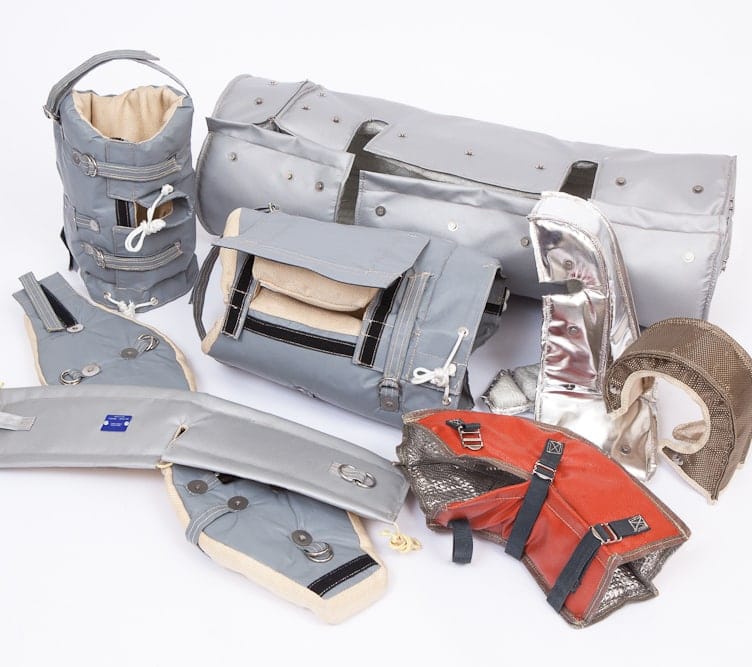
Insulation jackets are custom-made covers designed to provide thermal protection for industrial equipment and systems. These jackets consist of three primary components:
Outer Protective Cover: This layer shields and protects the insulation from environmental factors such as moisture, dust, and physical damage. It’s typically made of durable materials like polyester, nylon, or specialized weather-resistant fabrics.
Insulation Mat: The core material providing the actual heat containment, commonly made from fiberglass, wool, or Aerogel. Insulation thickness can range from ½ inch to 4 inches, depending on the required heat retention. For high-heat applications, a thicker insulation mat may be necessary.
Inner Liner: Positioned inside the jacket, the liner keeps the insulation mat in place and may also act as an additional barrier to protect the insulation from contaminants like oils or fluids.
In addition to these core components, insulation jackets include fastening systems such as stainless steel lacing wire, straps, springs, snaps, or Velcro to ensure a tight and secure fit around the equipment.
Installing insulation jackets on industrial equipment brings several advantages, including:
Without proper insulation, heat can leak from thermal systems, reducing energy efficiency and increasing the ambient temperature of the surrounding environment. Insulation jackets prevent heat loss, ensuring better energy efficiency and more comfortable conditions for workers.
The improved thermal efficiency resulting from insulation jackets directly translates into reduced operational costs. By preventing heat loss, companies can lower energy consumption, leading to significant savings. Some government energy efficiency programs even offer rebates for insulation installations, further reducing the initial investment.
Industrial equipment often reaches extremely high temperatures. Without insulation jackets, employees are at risk of burns, heat stress, and accidents caused by slips due to condensation. Insulation jackets help mitigate these risks by reducing the surface temperature of equipment and minimizing the chance of dangerous conditions such as fire or burns.
Insulation jackets protect industrial systems from environmental factors such as weather, extreme temperatures, and condensation. These elements can cause corrosion, metal expansion, or contraction, leading to premature failure. By stabilizing temperature and protecting sensitive components, insulation jackets help prolong the life of machinery and reduce maintenance costs.
The material used for an insulation jacket is crucial to its performance and longevity. Different materials provide varying levels of insulation, durability, and resistance to environmental factors. Common materials used include:
Aerogel: Known for its superior insulating properties, Aerogel provides excellent heat retention while remaining lightweight. It’s ideal for compact spaces with high insulation needs.
Fiberglass: A popular choice, fiberglass is odorless, resistant to corrosion, and has a high heat tolerance, making it effective in many industrial applications.
Mineral Wool: Includes materials like glass wool, rock wool, and slag wool, which offer excellent thermal resistance and moisture protection.
Wool (CMS Wool): Known for its fire-retardant properties, wool is suitable for high-temperature environments and provides additional resistance to mold and vermin.
Proper installation is critical for the effectiveness of insulation jackets. At Eas-fiberglass, the installation process for typical fastening systems, such as stainless steel lacing wire, involves the following steps:
Positioning the Jacket: Lay the jacket over the equipment to ensure proper placement.
Looping the Wire: Create metal wire loops that are fed from beneath the equipment and hooked onto rivets.
Securing the Jacket: Tighten and wrap the wire around the first rivet, and continue to the top rivet to secure the jacket tightly.
Finishing: Repeat this process along the jacket, ensuring the insulation is evenly placed and securely fastened. Snip off excess wire and tuck it away to avoid any safety hazards.
Additional installation tips include overlapping blankets last, using flaps with internal wires to tightly secure the under blanket, and ensuring the ends of the insulation jacket are even for a seamless fit.
At eas-fiberglass, we offer a wide range of custom insulation jackets, suitable for various industrial applications, including engine exhausts, exhaust piping, and industrial valve covers. Our insulation jackets are designed to meet the unique needs of each system, offering durable, heat-resistant materials that improve thermal efficiency and ensure safety.
Our products include:
Removable Insulation Jackets (Blankets or Covers): These are available in various sizes and configurations to fit the specific needs of each industrial component.
Customizable Designs: Firwin offers fully customizable jackets to suit different operational conditions, including temperature ranges, space constraints, and regulatory requirements.
Insulation jackets are a highly effective solution for enhancing thermal management, improving energy efficiency, and protecting both equipment and employees. By using high-performance materials such as Aerogel, fiberglass, and CMS wool, these jackets provide long-term protection against heat loss, extreme temperatures, and condensation. Whether you need to protect exhaust systems, valves, or other critical components, Eas-fiberglass offers custom insulation solutions tailored to your industrial needs, ensuring optimal performance and reduced operational costs.